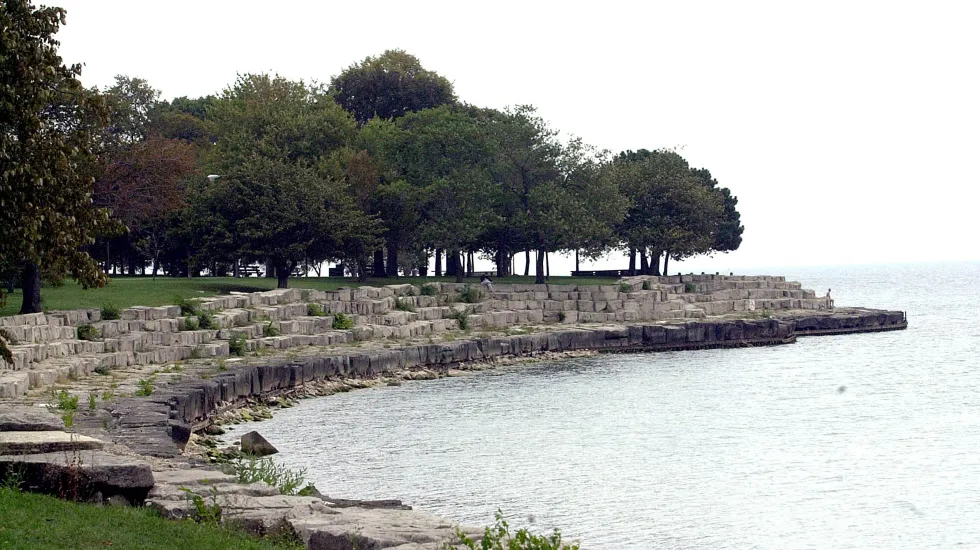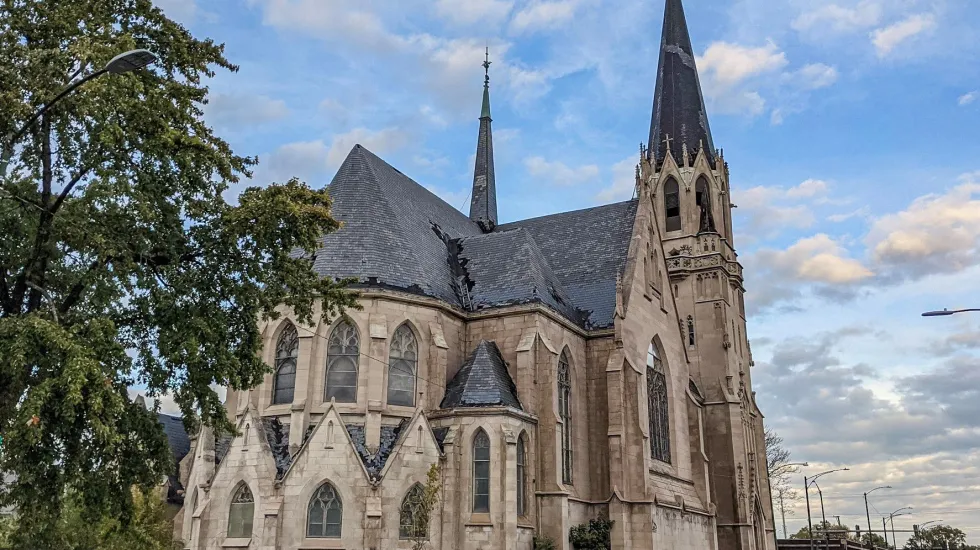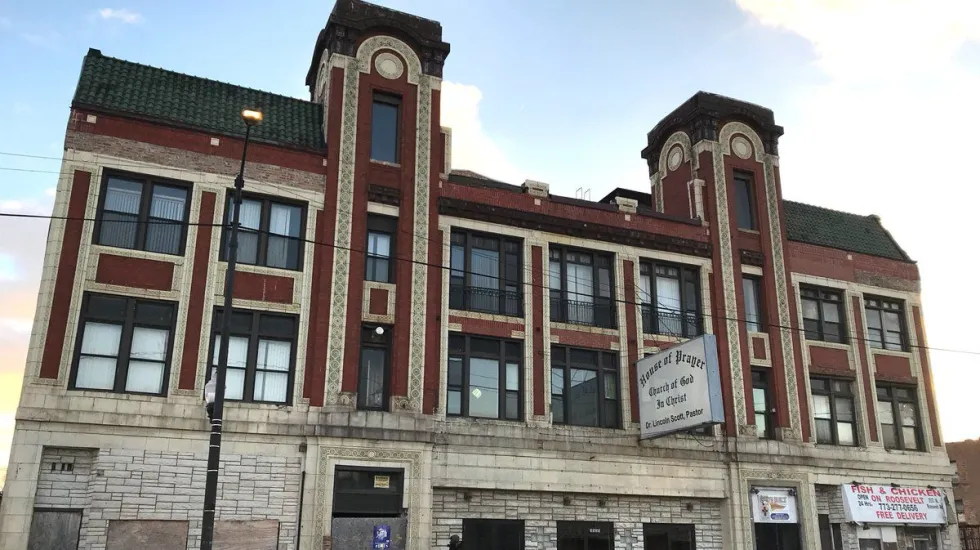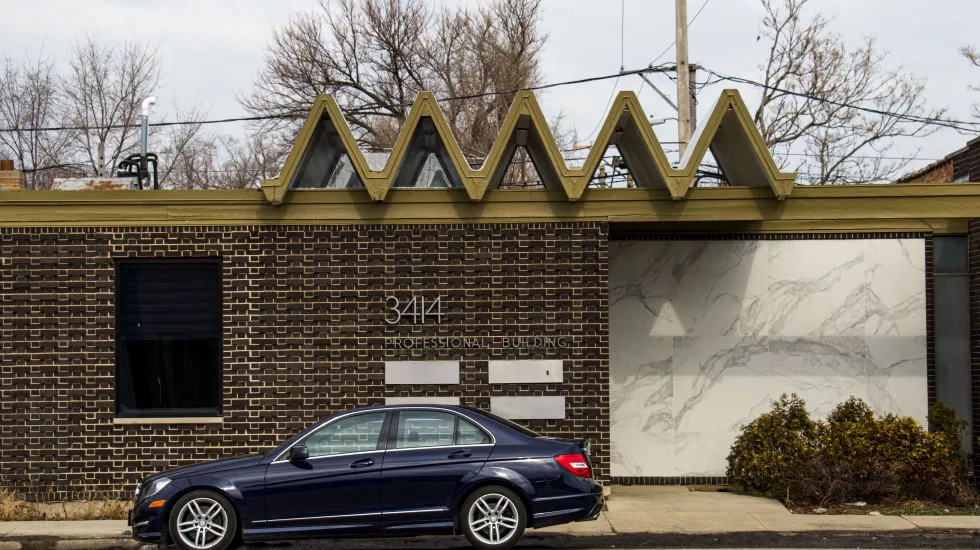
Promontory Point, one of the most beloved spots on the south shoreline of Lake Michigan, has been named to Preservation Chicago’s annual “most endangered” list.
The peninsula in Burnham Park is among eight historic buildings or public assets that made the list. It’s usually a list of seven, but the group threw in an additional site this year.
Built 84 years ago between 54th and 56th streets, Promontory Point’s revetment — limestone slabs forming giant steps along the water — has deteriorated over the years, thanks to rising waters and natural decay.
Now, Preservation Chicago contends, the city and Chicago Park District plan to tear out the limestone and replace it with concrete slabs, “destroying not only the historic stepstone revetment, but also the naturalistic aesthetic of this Alfred Caldwell-designed park,” Preservation Chicago said in its report. “This irreversible alteration will adversely affect the open and diverse community culture that has thrived for decades at Promontory Point, moving this historic site further away from its original design and setting a precedent for future unsympathetic alterations.”
Caldwell was an architect with the Chicago Park District and designed the landscape plan for Promontory Point.
According to the preservation group, the city has a history of replacing limestone along the lakefront with massive concrete and steel structures — everywhere except The Point.

“Today, the historic revetment at Promontory Point is all that is left of a once eight-mile-long stretch of beautiful limestone transitions between nature and the city,” Preservation Chicago said.
Preservation Chicago said despite its age, the revetment continues to protect the parkland behind it from the harsh waves of Lake Michigan, though major repairs are needed.
The advocacy group has recommended the city and Chicago Park District designate The Point as a Chicago landmark, making it nearly impossible for it to be demolished.
Preservation Chicago has made its list every year since 2003 to call attention to the risk facing not-yet-classified landmarks and what it would mean to lose such historic structures.
“It’s a somber time as we spotlight these remarkable endangered structures which cover so much area of the city,” said Ward Miller, executive director of Preservation Chicago. “The threats to our historic built environment are all across Chicago, but we have hope for our city that these places can be reused, repurposed and protected, making them a cornerstone to grow communities sensitively and holistically.”
Also on Preservation Chicago’s 2022 list:
Cabrini Row Houses, Lathrop Homes-South Campus and two non-residential buildings at Altgeld Gardens: The Chicago Housing Authority has demolished many of its buildings over the years, with the promise to attract more affordable housing — a promise not yet met, according to Preservation Chicago.
Instead, Preservation Chicago wants those parts of the Cabrini, Lathrop and Altgeld complexes restored and put back “into good use for the people.”

St. Martin de Tours: The Gothic structure at 5848 S. Princeton, was designed by architect Henry J. Schlacks for a Catholic parish in Englewood that at the time had a predominantly German congregation..
As the neighborhood changed, it continued to thrive for years as a parish with a mostly Black congregation. But it closed in 1989 and since then has remained untouched and suffered significant deterioration.

Central Park Theater: Preservation Chicago said this building at 3535 W. Roosevelt Rd. has contributed significantly to the arts and culture of North Lawndale from the time it opened in 1917.
It has been the home of House of Prayer Church of God in Christ since 1971. But over the past five decades, it has deteriorated and the list of needed repairs has grown immensely as the churches congregation has dwindled.

Peterson Avenue Mid-century Modern District: This two-mile stretch from North Park to West Ridge hosts an ensemble of Mid-century Modern architecture.
However, many of those uildings along Peterson Avenue are under threat of demoltion, and many other already have been torn down.

The Century and Consumers buildings: The Century at 202 S. State St. and the Consumers at 220 S. State St. are in the heart of the Chicago Loop and in the city’s Central Business District.
Despite that prime location, they are suffering from both low occupancy rates, as well as years of deferred maintenance, causing concern for their future.
The site has made the list before.
Preservation Chicago called the Century “a rare example Neo-Manueline” architecture, a Portuguese style that influenced architecture in the Midwest. And the Consumers building (foreground in picture) is clad in white architectural terra cotta, made in Chicago.

North DuSable Lake Shore Drive: The once “slow-paced, boulevard parkway” has morphed into a quasi-highway that has gradually removed its aesthetic of being a road Chicagoans can use to enjoy the city’s beautiful lakefront, the preservation group contends.
To prevent that situation from getting any worse, Preservation Chicago recommends rebuilding bridges and underpasses. It also opposes any further widening of the road to add more lanes.

Moody Triangle: This site in Chicago’s Old Town neighborhood is bounded by Clark Street, North Avenue, and LaSalle Drive.
In it are three buildings that Preservation Chicago believes are threatened by looming redevelopment around the campus of Moody Bible Institute: the Wintrust Bank building, 100 W. North Ave; Moody Memorial Church, 1635 N. LaSalle Dr.; and Archway Standard Station/BP Service Station, 1647 N. LaSalle Dr.








